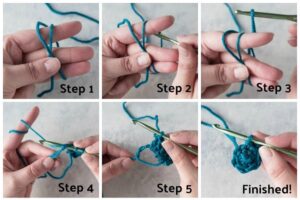Let’s explore the world of crochet, where a single hook and thread can weave intricate patterns that captivate the eye and warm the heart. Crochet is a method of creating fabric by interlocking loops of yarn or thread. It has been cherished for centuries, allowing artisans to craft delicate garments and home decor.
We will unravel various stitches and techniques that form the basis of this captivating craft. From basic single crochet stitch to complex Tunisian patterns, each stitch harnesses its own unique character. We can express our artistic visions with an abundance of textures and shapes.
The artistry of color selection is like painting with threads, letting us evoke emotions through harmonious blends or contrasting colors. Exploring different yarn fibers enhances our creations’ tactile allure.
Crochet’s origins intertwine with archaeological traces dating back to early civilizations. This beloved art form has changed across continents and cultures.
Let’s be inspired by crochet’s timeless charm and embrace the endless possibilities at our fingertips. With dedication and imagination, may our journey through stitches reveal beautiful creations and opportunities for personal growth and artistic fulfillment.
Essential Materials for Crochet
Crochet kits need certain materials for beginners. These items form the basis of your crochet adventure and guarantee you have everything for making beautiful patterns.
- Crochet Hooks: Pick ergonomic hooks that are simple to use and comfortable to hold. Different sizes are needed for various projects, so it’s great to have a selection.
- Yarn: There is no limit to yarn options. Pick soft yarn like acrylic or cotton, to start. Explore different textures and shades to give your projects character.
- Scissors: A sharp pair of scissors is a must for cutting yarn and trimming loose ends. Look for blades that can easily go through tight stitches.
- Tapestry Needle: This needle is used to weave in ends and attach pieces. Choose a needle with a blunt tip to avoid splitting yarn or spoiling the project.
A few other materials can also improve your crochet experience. Stitch markers help keep track of your work, and a measuring tape is great for checking gauge.
Crochet has been around for centuries, with early examples from 16th century Europe. Steel crochet hooks became accessible in the 1800s, which made crocheting more available.
As technology developed, different types of yarn and tools were invented. Now, there are a lot of materials and accessories, so crocheters can be creative in many ways.
Basic Crochet Stitches
Crochet art is not mastered without a firm grip on the basic stitches. These are the building blocks for creating intricate designs. Here’s a list of four must-know basic crochet stitches for beginners:
- Chain Stitch: This is the most primary stitch. It creates a loop foundation for other stitches.
- Single Crochet: This stitch is both simple and versatile. It produces a dense fabric often used for making scarves, blankets, and garments.
- Double Crochet: This stitch adds texture and height to your work. It’s ideal for lacy patterns, blankets, and shawls.
- Treble Crochet: Taller than the double crochet, this stitch helps you cover more ground quickly. It’s perfect for openwork designs and produces light projects.
To master these basics, pay attention to the finer details. Keep consistent tension throughout your work – loose or tight stitches affect the overall look. Quality yarn and right hook sizes also matter. Try different materials and tools to find what works best for you.
Mixing various stitch combinations gives depth to your creations. Explore patterns online or in books that incorporate multiple basic stitches. Dedicate time and practice to perfect these basics. Patience is key. Don’t be discouraged if it takes time. Enjoy the process of learning this craft and let your creativity flow through each stitch.
Reading Crochet Patterns
Reading crochet patterns is super important for beginners. With just a hook and yarn, you can make stunning designs! Here are some must-knows when reading these patterns:
- Stitches: Crochet patterns use abbreviations for different stitches, such as sc (single crochet), dc (double crochet) and tr (treble crochet). Learn these abbreviations to understand the instructions.
- Gauge: Gauge determines the size of your finished project. Match the measurements in the pattern and adjust your hook size if needed.
- Repeat Instructions: Asterisks (*) or brackets ([]): Repeat specific sections or stitches throughout the pattern.
- Charts: Charts/diagrams visually represent the stitch placement. Learn how to read these to understand complex patterns.
- Note: Read the notes/tips in the pattern. They may provide guidance or variations.
Pay attention to yarn requirements, like weight or fiber type. Note any unique techniques or stitches.
My friend Sarah’s story shows why understanding and interpreting crochet patterns correctly is key. She skipped a row of decreases and her blanket turned out too big.
Now you’re ready to start crocheting! Practice makes perfect and you’ll soon be making amazing pieces!
Crochet Techniques for Beginners
Crochet is an art that beginners must master. Here’s a step-by-step guide to get you started:
1. Choose your hook and yarn:
- Get a crochet hook that feels comfy in your hand.
- Go for medium-weight acrylic yarn, which is great for beginners.
2. Learn the basics:
- Slip Knot: Make a loop with the end of your yarn and pull the working yarn through.
- Chain Stitch (ch): Pull the working yarn through the slip knot in a smooth motion to create a foundation chain.
- Single Crochet (sc): Put your hook into the next stitch, yarn over, and pull up a loop. Yarn over again and pull through both loops on your hook.
- Double Crochet (dc): Yarn over, insert your hook into the next stitch, yarn over again, and pull up a loop. Yarn over once more and pull through two loops on your hook. Do this step once more.
3. Practice tension control:
- Pay attention to your tension. It decides how tight or loose your stitches are.
- Hold your hook and yarn comfortably but not too tightly.
4. Follow patterns or create your own:
- Begin with easy projects like dishcloths or scarves to learn different techniques.
- Play around with different stitches and color combos to show your creativity.
Remember, practice makes perfect! Join online communities or take classes to learn from experienced crocheters and get inspired.
Start learning these beginner techniques today and let crochet be a source of relaxation, fulfillment, and self-expression in your life! Don’t miss out on the beauty of crochet!
Crochet Projects for Beginners
Are you new to crochet? Not sure what kind of projects to begin with? Here are some ideas!
- Baby Blankets: These are great for practicing stitches and making something practical.
- Scarves: Try different yarns and stitch patterns. Keep toasty in the winter months.
- Dishcloths: Quick projects for learning new stitches and techniques. Great gifts too!
- Amigurumi: Challenge yourself with these adorable crocheted stuffed animals.
- Hats: Move on to hats when your skills are up. Beanies, slouchy hats – be creative!
Choose patterns with clear instructions and take your time. Enjoy the satisfaction of mastering this art form! Grab your yarn and hook and let the creativity flow. Start your crochet journey today!
Tips and Tricks for Mastering Crochet
Crochet is a complex art form that needs skill and practice to perfect. Here’s some help for beginners.
- Be consistent. To make neat stitches, maintain the same yarn tension. Practice with different yarn weights and adjust your grip.
- Pick the right hook. The hook size affects project outcome. Try different sizes for desired stitch tension.
- Practice daily. Like other skills, crochet needs practice. Dedicate a few minutes each day to work on projects.
For a polished look, use stitch markers to track pattern repeats or change colors.
My friend experienced crochet frustration. But she kept trying and sought help online. With guidance and determination, she overcame struggles and now creates amazing blankets.
Remember, mastering crochet takes time and patience. Embrace the learning process. Experiment with different techniques. Soon you’ll make stunning crocheted creations!
Conclusion
Mastering the Art of Crochet: Essential Skills for Beginners is a great guide. We’ve looked at different techniques and tips to help beginners. From learning basic stitches to creating intricate patterns, it’s all here!
Practice is very important to master crochet. Dedicate time and effort to hone your skills and you’ll get great results. Experiment with different yarns and hooks to open up a world of possibilities.
Crochet has plenty of benefits too. Studies show it can reduce stress, improve cognitive function and promote well-being. So you’re getting a skill and investing in your mental health!
“Crochet Today” magazine highlights the importance of perseverance. With time and dedication, beginners can become skilled artisans. Design intricate patterns, or even develop your own style.
We have explored essential crochet skills for beginners. With practice, patience and passion anyone can master this art. Create cozy blankets or fashionable garments – the possibilities are endless! So pick up your hook and let your creativity unravel!
Frequently Asked Questions
Q: What supplies do I need to start crocheting?
A: To start crocheting, you will need a crochet hook, yarn, scissors, and a tapestry needle.
Q: How do I hold the crochet hook and yarn?
A: Hold the crochet hook in your dominant hand like a pencil, and hold the yarn with your non-dominant hand. Experiment with different grips to find what feels most comfortable for you.
Q: How do I do a basic crochet stitch?
A: To do a basic crochet stitch, make a slipknot, then insert the hook through the loop and yarn over. Pull the yarn through the loop on the hook, creating a chain stitch. Repeat this process for subsequent stitches.
Q: What are the essential crochet stitches for beginners?
A: The essential crochet stitches for beginners include chain stitch, single crochet, double crochet, and slip stitch. These stitches form the foundation for most crochet projects.
Q: How do I read crochet patterns?
A: Crochet patterns typically use abbreviations to represent different stitches. For example, “sc” stands for single crochet and “dc” stands for double crochet. The pattern will also include instructions on stitch placement and repeats.
Q: How can I fix mistakes in my crochet work?
A: To fix mistakes in crochet, you can use a crochet hook to carefully “frog” or unravel the stitches back to the mistake. Alternatively, you can carefully “tink” or undo the stitches one by one using a crochet hook.



